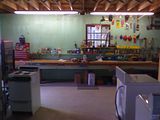I enjoy building scale model vehicles . . . especially fire trucks such as the one pictured above. It, by the way, is a 1/25th scale model of Sag Harbor, New York's American-LaFrance rear-mount aerial. I first got interested in model building when I was about 12 or 13 years-old . . . but it has taken me this long (35 years) to really get proficient at it and even begin to have mine look as good as the one pictured above. To that end, I'd like to share a little bit of what I've learned over that time:
Take your time!
I learned early on that building scale models is not a hobby where you can rush and be successful. Once parts have been put together, the glue needs time to set so that they will stay together -- this is especially true with heavier parts or parts that will have others attached to them.
Have a designated work area

Although most model builders - myself included - dream of having a shop where you can work on projects, a kitchen table will work just fine. Two things to keep in mind when selecting your work area: 1) Does it have good natural lighting or good overhead lighting?; and 2) is the area easily ventilated? The latter is especially important if you're working in the house because it doesn't take long for fumes from the glue and paint to make your work area smell like a nail shop. (For the guys reading this who might not understand, ask your wife or girlfriend.)
Cleanliness is next to godliness
Okay, maybe it's not quite that important . . . but it can mean the difference between a really sharp looking one and one that has a smudged paint job or glue residue "fingerprints". It's easy to do too by washing your hands after you finish painting parts (and, of course, giving them ample time to dry.) Something else that I find helpful is to use latex gloves as this also helps to prevent the oils on your skin from getting on the plastic which can also mess up paint and cause glue not to adhere properly.
Use quality products
Normally I treat product preference as a matter of personal choice, however, in the case of model building, I have to suspend my rule and recommend Testors. In my personal opinion, you can't beat their model cement for adhesion and their paints give a beautiful finish every time! Check out their website at: http://www.testors.com/model_and_hobby.
And, last, but not least . . .
Don't work on days when the humidity is high
When the humidity is high, paint - and glue - tend to dry very slowly and remain tacky for a LONG time. With that in mind, it's best to postpone working on models on damp or rainy days (unless you're able to do some REALLY tight climate control).

Until next time . . .
Take your time!
I learned early on that building scale models is not a hobby where you can rush and be successful. Once parts have been put together, the glue needs time to set so that they will stay together -- this is especially true with heavier parts or parts that will have others attached to them.
Have a designated work area

Although most model builders - myself included - dream of having a shop where you can work on projects, a kitchen table will work just fine. Two things to keep in mind when selecting your work area: 1) Does it have good natural lighting or good overhead lighting?; and 2) is the area easily ventilated? The latter is especially important if you're working in the house because it doesn't take long for fumes from the glue and paint to make your work area smell like a nail shop. (For the guys reading this who might not understand, ask your wife or girlfriend.)
Cleanliness is next to godliness
Okay, maybe it's not quite that important . . . but it can mean the difference between a really sharp looking one and one that has a smudged paint job or glue residue "fingerprints". It's easy to do too by washing your hands after you finish painting parts (and, of course, giving them ample time to dry.) Something else that I find helpful is to use latex gloves as this also helps to prevent the oils on your skin from getting on the plastic which can also mess up paint and cause glue not to adhere properly.
Use quality products
Normally I treat product preference as a matter of personal choice, however, in the case of model building, I have to suspend my rule and recommend Testors. In my personal opinion, you can't beat their model cement for adhesion and their paints give a beautiful finish every time! Check out their website at: http://www.testors.com/model_and_hobby.
And, last, but not least . . .
Don't work on days when the humidity is high
When the humidity is high, paint - and glue - tend to dry very slowly and remain tacky for a LONG time. With that in mind, it's best to postpone working on models on damp or rainy days (unless you're able to do some REALLY tight climate control).

Until next time . . .

